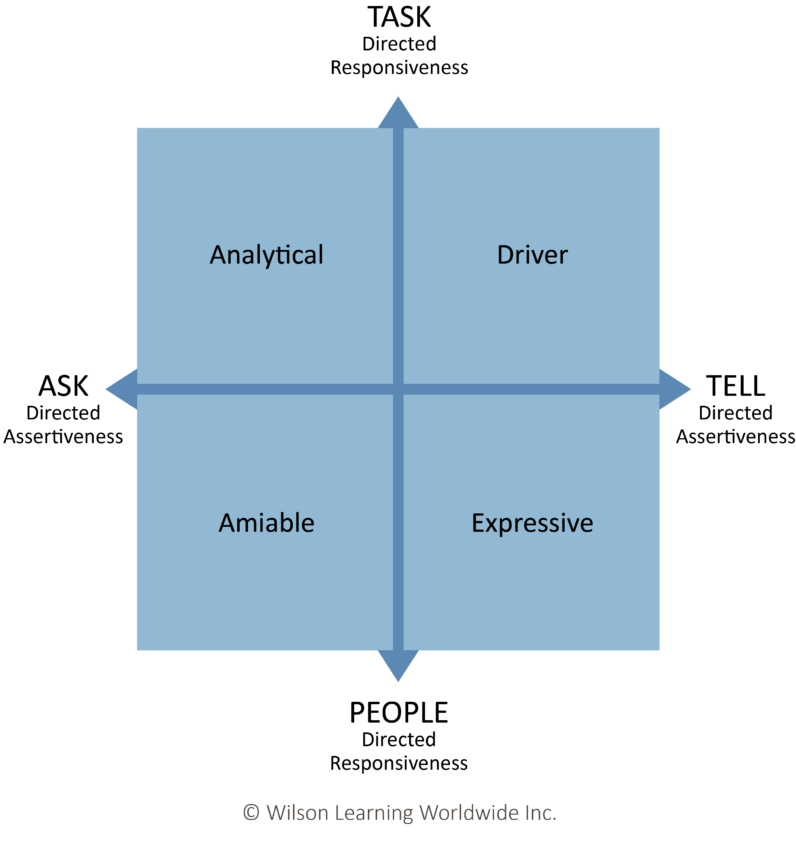In every organization, there is a hidden diversity—the diversity of Social Styles. Leveraging Social Style differences can lead to more effective collaboration, productive relationships, and greater productivity and business results. Recognizing others’ work preferences and adjusting to them results in more efficient communication and the persuasive ability to influence others. Improving versatility reduces tension in relationships and allows people to focus on the task and work to be done.
Building Relationship Versatility: Social Styles at Work™ (BRV) is built around a four-quadrant Social Styles matrix. After being profiled, participants are assigned a Social Style, interpersonal versatility rating, and specific versatility behaviors. They learn how to identify others’ Social Styles and, based on understanding their own and others’ styles, learn to modify their own behaviors to communicate more easily and effectively with others.
The Social Styles Model

Program Outcomes
Building Relationship Versatility provides participants with results-oriented versatility skills that help them improve their ability to work effectively with others. Individuals are better able to build productive relationships, handle conflict, and create more focused and productive teams.
Building Relationship Versatility offers practical skills and tools to help both managers and individual contributors.
From Learning to Performance
To ensure improved performance, Wilson Learning believes that your employees must gain new perspectives on their role, along with acquiring new skills and tools in order to take responsibility for driving improved results.
New Perspectives: The WHY
Learning is as much about acquiring new attitudes, or mindsets, about your job as it is about skills. For example, a participant can learn how to identify others’ Social Styles, but until they understand the importance of versatility—and how their versatility impacts their interactions with others and why that requires them to change—there will be limits to their perception of the value of these skills.
New Skills: The WHAT
It is not enough to just convince participants that they need to think and act differently; they need to learn specific skills, behaviors, and have a process to turn it into reality. If you want real change in job performance, both new perspectives and new skills are required.
New Tools: The HOW
New skills will not be applied on the job without tools and procedures to support their use. We believe it is critical to support every new skill with tools, job aids, and reinforcement to help people apply these skills.
The Performance Improvement Journey
Effective individual development does not occur from isolated training events. We believe that a series of structured activities that build upon one another is essential in order to develop new skills and ensure they are actually applied.
- Participant Readiness prepares participants and managers for the overall learning experience.
- Application and Practice are embedded into the design to ensure the new skills get used and are fully integrated into the participant’s interactions with others.
- Organizational Alignment maximizes organizational support and reinforcement for the use of the new skills.
As a result of this integrated approach, participants will continue to apply the skills and tools learned long after the learning event is completed.
To discover how we ensure learning is reinforced and applied for improved performance, read more about our Learning Journeys.
Measurement
Follow-up measurement options are available, including interviewing guidelines for participants and managers, behavioral checklists, and the Social Style Profile (used twice, first in the preparatory stage and later to measure shifts in perceived versatility). This concrete, real-world feedback motivates people to perform and acts as a blueprint for creating individual, group, and organizational development plans.
Evaluation
Wilson Learning will partner with your organization to measure the initial behavioral changes and business results. We will work with you to set up evaluation systems that help improve outcomes and sustain the momentum of your implementation.
To learn more about measuring the impact of learning, visit Measurement.
To view our current public workshops for this program, visit Workshops.

